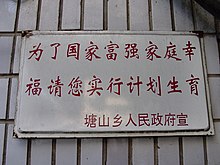One-child policy
This article needs to be updated. (February 2016) |
The one-child policy (or family planning policy) was a policy introduced in the People's Republic of China in the year 1979. Mao Zedong had thought that a bigger population resulted in a stronger country, but of course, they faced a lot more problems. China had gone above carrying capacity and there were not enough resources, such as food, water and only 7% of their land was for farming. for everyone. After the Second World War, the Chinese population grew quickly. In September of 1980, the one-child policy was introduced. The policy was introduced to control population growth and declares that Chinese families should only have one child. There are a few exceptions to this rule.

"For a prosperous, powerful nation and a happy family, please use birth planning."
Beyond the exceptions, if a couple wanted to have more than one child, they must pay money to the government. In some places in China, couples were able to get a permit so they would not have to pay the fee. Because most families would not be able to afford the fee, women were often forced to have an abortion.[1] There were punishments for those who had a second child. However, if the first child were to be a female, the couple could try to have a second child, in hopes of a male child. Since it was started in 1979, the policy has prevented 400 million births from happening.[2] About 36% of the Chinese population is affected by the rule.[3] The policy does not apply in some areas, such as Hong Kong, Macau or Tibet.
After more than 30 years of the one-child policy, China started to face a population ageing problem. And as the Chinese economy developed rapidly in recent years, the workforce also became tight. In 2015, it was decided that the one-child policy was to be removed and instead allowed couples to have two children for the first time in thirty years. Effective from January 2016, the one-child policy was replaced by a two-child policy, allowing each couple to have two children.
Even before the policy was introduced, China took many steps to encourage families to have fewer children. These steps included messages preaching the importance of family planning. There was one such of these messages that was a sign put up in Tang Shan that read, 'For a prosperous and powerful nation and a happy family, please use birth planning'. There were also incentives and rewards for those who only had one child, which continued through the one-child policy. Some of these included access to government services, better employment opportunities, higher wages, longer maternity leave, quality childcare, and better housing.
As of August 2021, the two child policy increased to three children. This is because of the decline in China's population
References change
- ↑ "China's One-Child Policy Turns 33 as Forced Abortions, Female Infanticides Continue". LifeNews.com. 25 September 2013. Retrieved 4 October 2021.
- ↑ BBC: China steps up "one-child policy".
- ↑ "Most people free to have more child". 7 November 2007. Archived from the original on 17 October 2008. Retrieved 31 July 2009.